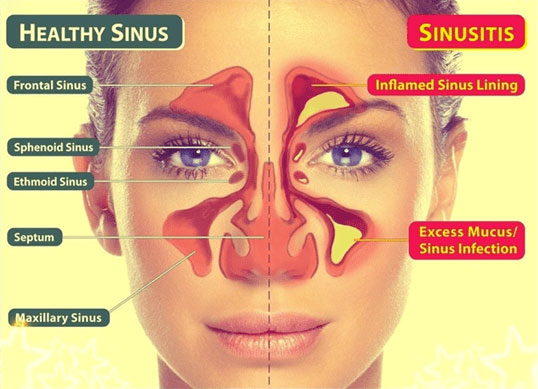
SINUSITIS…IT’S SNOT FUNNY!
I’m sure many of you can relate to the photo above, especially during this season change. We’ve always been told, “April showers bring May flowers.” Well, what they forgot to mention is April showers bring snot, snot, and more snot! The time has come where we start suffering from the notorious sinusitis. We find ourselves asking many questions as to why our sinuses are misbehaving. Today I will provide you with some fun facts to get you through these bothersome months.
What is really going on in my noggin?
Lets start with how things are supposed to work. Our normal sinuses are air-filled cavities lined with a thin layer of mucus that traps foreign bodies floating in the air, such as dust and germs. Our normal sinuses are also lined with hair-like projections that act like tiny brooms in our nasal passages. They sweep the mucus (and whatever germs, dust, etc. are trapped in it) towards openings that lead to the back of the throat. From there, it slides down to the stomach. This is what should actually happen when our sinuses come into contact with any irritants.
When you become an unfortunate victim of sinusitis, your normal sinuses become inflamed. This means the normal flow of mucus from the sinuses to the back of the throat is disrupted. The tiny “sweepers” in our sinuses become blocked because of all this swelling and inflammation, which causes our mucous to become trapped in our sinuses. Mucous and pressure build up in the sinuses of our face, which cause us to experience the common symptoms of sinusitis (for example, when you feel as though your head is a balloon that is about to “pop”).
The following picture shows this process perfectly. The picture also shows the four culprits of sinusitis:
- The ethmoid sinuses are located between your eyes.
- The maxillary sinuses are located over your cheeks – these are large and most commonly affected.
- The sphenoid sinuses are located behind your eyes.
- The frontal sinuses are located across your forehead.

How do I know if I am experiencing sinusitis?
The most common symptoms of sinusitis include:
- Postnasal drip (mucous dripping down throat)
- Discolored nasal discharge (often times yellow-green in color)
- Facial pressure
- Tenderness of the face (often times over the cheeks or at the bridge of the nose)
- Headaches over forehead
- Pain over the teeth
- Coughing
- Nasal congestion
- Sore throat
- Fever
- Fatigue
- Body aches
- Bad breath
How have I become one of the many victims of sinusitis?
You have likely come in contact with a bacteria, a virus, an allergen, or even a fungus, like mold.
Viral sinusitis is the most common form of sinusitis. Over 90 percent of sinus infections are viral in nature. This means that most of our sinus infections will start to improve over the course of about 10 days, with a little help from our over-the-counter friends!
Seasonal allergies can cause sinusitis symptoms as well; this happens when our body reacts to an unwelcome invader that we have an allergy to, such as pollen or dust mites. These symptoms will typically be more allergic in nature, including sneezing, watery eyes, nasal congestion, and a scratchy throat. As mentioned above, we are all becoming quite familiar with these symptoms as spring is in full bloom.
Bacterial sinusitis is a lesser common form of sinusitis. In fact, research shows bacteria account for less than 2% of all our sinus infection. A bacterial sinus infection differs from the other types of sinusitis in the fact that symptoms will often not start to improve by day 10. Also with a bacterial sinus infection you are more likely to experience severe facial pain and fever. It is important to know that both viral and allergic sinusitis have the risk of turning into a bacterial sinus infection, therefore it is important to treat your symptoms. Our goal is to move that snot!
What can I use to treat my symptoms?
- Topical nasal steroids can actually reverse inflammation and swelling in your sinuses, addressing the biggest problem associated with sinusitis. These sprays are my favorite because not only does a steroid spray work wonderfully for inflammation, but also the spray is not absorbed into your blood stream. Meaning this is safe for long-term use and you are not predisposed to the crummy adverse effects of an oral steroid! Examples include Flonase nasal spray and Rhinocort nasal spray.
- Saline nasal sprays are rinses that help clear out thick mucous from our nasal passages, reducing that facial “pressure” you feel and making it easier to breathe. Examples include Ocean nasal spray and Xlear nasal spray.
- Topical nasal decongestants are very effective at decreasing swelling and moving mucous through the nasal passages. However, these should not be used for more than a few days since they can actually worsen your congestion if overused. Examples include Afrin nasal spray.
- Antihistamines can decrease inflammation if your sinus inflammation is caused by exposure to an allergen. Antihistamines should become your best friends during these sneezy months! Antihistamines come in the form of oral tablets, nasal sprays, inhalers, and eye drops. Examples include Zyrtec, Claritin, Benadryl, and Astelin nasal spray.
- Non-steroidal anti-inflammatories: these are great at decreasing inflammation, reducing pain, and relieving fever. Examples include Ibuprofen and Naproxen.
- Oral decongestants can be very effective at relieving congestion by drying our mucous. These medications are my least favorite, as research shows they are not any more effective than the medications above AND have many more side effects. For example, these medications should not be used for more than a few days and also should not be used by someone who has high blood pressure, heart disease, glaucoma, etc. Examples of these include Zyrtec-D and Sudafed.
While the above medications are a great start to treating your sinusitis symptoms, it is important to read the labels carefully in order to safely use these medications. If you are uncertain as to whether a medication is safe for you to use, please ask your primary care doctor to advise before taking.
When is it time to come see us?
The Centers for Disease Control and Prevention (CDC) can give you guidance on when to pay us a visit for your sinusitis symptoms. Please visit our walk-in clinic or make an appointment with your primary care provider if you are experiencing:
- Severe symptoms, such as severe facial pain or severe sore throat.
- Symptoms that get worse after initially improving (this is called “double sickening”).
- Symptoms lasting more than 10 days without improvement.
- Fever persisting longer than 3-4 days OR fever greater than 102F.
- Repeated sinus infections.
These symptoms indicate you may be experiencing a bacterial sinus infection, which could require antibiotics to resolve. This is also not a comprehensive list of symptoms, therefore please do not hesitate to reach out to Cool Springs or North Franklin Internal Medicine and Pediatrics if you have any concerns regarding your current sinus symptoms.

I hope this newsletter has provided some clarity on the ambiguous nature of sinusitis! Please visit the following website for more information on CDC fun facts regarding sinusitis:
https://www.cdc.gov/antibiotic-use/community/for-patients/common-illnesses/sinus-infection.html
References:
- https://www.champlainmedical.com/blog/health-wellness/sinusitis-it-s-snot-funny
- https://acaai.org/allergies/types/sinus-infection
- https://www-uptodate-com.bunchproxy.idm.oclc.org/contents/uncomplicated-acute-sinusitis-and-rhinosinusitis-in-adults-treatment?search=sinusitis&source=search_result&selectedTitle=1~150&usage_type=default&display_rank=1
- http://www.otolaryngology-assoc.com/our_services/allergies__sinusitis.aspx
- https://www.cdc.gov/antibiotic-use/community/for-patients/common-illnesses/sinus-infection.html




